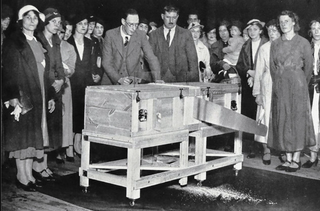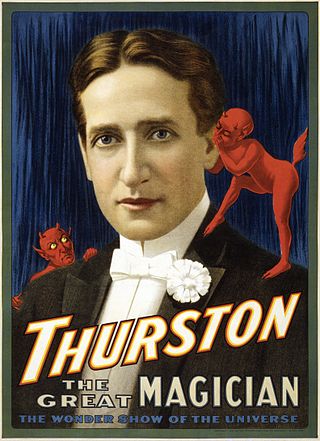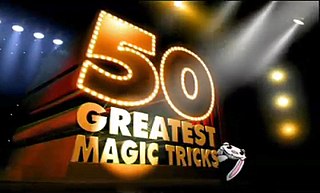
The Balducci levitation is a levitation illusion first described by Ed Balducci. Its inventor is unknown. It is an impromptu magic trick, which has been popularized by many magicians, such as David Roth, Paul Harris, and David Blaine.

Harry Kellar was an American magician who presented large stage shows during the late 19th and early 20th centuries.

Harry Bouton Blackstone Jr. was an American stage magician, author, and television performer. He is estimated to have pulled 80,000 rabbits from his sleeves and hats.

Sawing a woman in half is a generic name for a number of stage magic tricks in which a person is apparently cut or divided into two or more pieces.
The Asrah levitation, sometimes called Lighter than Air, is a classic levitation illusion.

Harry Bouton Blackstone was a famed stage magician and illusionist of the 20th century. Blackstone was born Harry Bouton in Chicago, Illinois. He began his career as a magician in his teens and was popular through World War II as a USO entertainer. He was often billed as The Great Blackstone. His son Harry Blackstone Jr. also became a famous magician. Blackstone Sr. was aided by his younger brother, Pete Bouton, who was the stage manager in all his shows. Blackstone Sr. was married three times. Blackstone Jr. was his son by his second wife.

Howard Thurston was a stage magician from Columbus, Ohio, United States. As a child, he ran away to join the circus, where his future partner Harry Kellar also performed. Thurston was deeply impressed after he attended magician Alexander Herrmann's magic show and was determined to equal his work. He eventually became the most famous magician of his time. Thurston's traveling magic show was the biggest one of all; it was so large that it needed eight train cars to transport his road show.
David Copperfield has performed a levitation illusion in several magic shows since 1992 in which he appears to fly on stage for several minutes, while surrounded by audience members. The flight is notable for its graceful motion and unencumbered appearance. The illusion was included in Copperfield's CBS TV special The Magic of David Copperfield XIV: Flying—Live The Dream (1992), and has been repeated several times during Copperfield's live tours around the world. The method was created by John Gaughan. An essential contribution to make fluid movements was given by his assistant, dancer and choreographer Joanie Spina.

Jim Steinmeyer is an American author, inventor, and designer of magical illusions and theatrical special effects. He holds four US patents in the field of illusion apparatus, including a modern version of the Pepper's Ghost illusion. Steinmeyer has consulted for many famous magicians, including David Copperfield, Doug Henning, Siegfried and Roy, and Lance Burton.

John Gaughan is an American manufacturer of magic acts and equipment for magicians based in Los Angeles, California. His style of work is classic, not based heavily on machinery and technology.
Origami is a magic stage illusion with a Japanese paperfolding theme, designed by Jim Steinmeyer. It was originally performed in 1986 by Canadian illusionist Doug Henning, using a working prop constructed by illusion builder John Gaughan. Illusionist David Copperfield later introduced presentational changes that would be widely copied by other performers.
Richiardi Jr., was the stage name of magician Aldo Izquierdo Colosi, who became famous for dramatic and gory stage presentations of classic stage illusions.

A magician's assistant is a performer in a magic act who is not billed as the magician or principal name in the act.

Johannes Franciscus Catharinus "Hans" Klok is a Dutch magician and illusionist.
Stage illusions are large-scale magic tricks. As the name implies, stage illusions are distinct from all other types of magic in that they are performed a considerable distance away from the audience, usually on a stage, in order to maintain the illusion. Stage illusions usually use large props and may involve the use of assistants or large animals. Examples of stage illusions include sawing a woman in half and Lady-to-Tiger.
Joanie Spina was an American dancer, choreographer, magician and director who achieved prominence through her work with the illusionist David Copperfield.
Clearly Impossible is a variation of the illusion of sawing a woman in half devised by Jonathan Pendragon.

Magic, which encompasses the subgenres of illusion, stage magic, and close-up magic, among others, is a performing art in which audiences are entertained by tricks, effects, or illusions of seemingly impossible feats, using natural means. It is to be distinguished from paranormal magic which are effects claimed to be created through supernatural means. It is one of the oldest performing arts in the world.

50 Greatest Magic Tricks is a one-off list show that was produced by Objective Productions for Channel 4. The programme counted down the fifty greatest magic tricks, as voted for by members of The Magic Circle. The illusion at number one was Death Saw by David Copperfield. The show was presented by British comedy duo Adam and Joe, who also wrote and narrated the programme. The show was first broadcast on Channel 4 on 6 May 2002.















